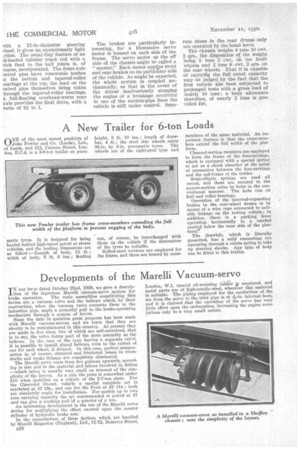Developments of the Marelli Vacuum-servo
Page 62

If you've noticed an error in this article please click here to report it so we can fix it.
IN our iss,ie dated October 22nd, 1929, we gave a description of the ingenious Marelli vacuum-servo system for brake operation. The main assemblies constituting this device are a vacuum valve and the bellows which, by their contraction, when the vacuum valve connects them to the induction pipe, apply a powerful pull to the brake-operating mechanism through a system of levers.
Since the date in question great progress has been made with Marelli vacuum-servos, and we learn that they are shortly to be manufactured in this country. At present they are made in five sizes, two of which are self-contained, that is to say, the valve forms part of the same assembly as the bellows. In the ease of the type having a separate valvO, it is possible to install plural bellows, even to the extent of One for each wheel, if de,sired. In this case, perfect compensation is, of course, obtained and frictional losses in crossshafts and brake linkage are completely eliminated.
The Marelli servo costs from five guineas upwards, according to size and to the material and labour involved in fitting —which latter is usually very small on account of the simplicity of the layout. As a rule the price is somewhat under £10 when installed on a vehicle of the 5-7-ton class. For the Chevrolet 30-cwt. vehicle a special complete set is marketed at £7 16s., and one for the Ford at £8 us. ; both are absolutely ready for installation. For models up to two tons carrying capacity the set recommended is priced at £7 and can give a working pull Of a quarter of a ton.
An interesting development is the use of the Marelli servo device for multiplying the effort exerted upon the master cylinder of hydraulic brake sets.
In the manufacture of these devices, which are handled by Marelli Magnetos (England), Ltd., 71-72, Bolsover Street, B28 •
London, W.1, special oil-resisting ru er is employed, and metal parts are of high-tensile-steel, wherever this material is suitable. The piping employed for the conduction of the air from the servo to the inlet pipe is of Ar-in. internal bore, and it is claimed that the operation of the servo has very little effect upon the carburation, increasing the engine revolutions only to a very small extent.




















































































































































